BATTAMBANG CITY – A week ago, a group of artists here celebrated the fourth anniversary of Sammaki, an ambitious community center open to anyone interested in the arts.
Sammaki is a reflection of the artists in the city: vibrant, successful but financially strapped.
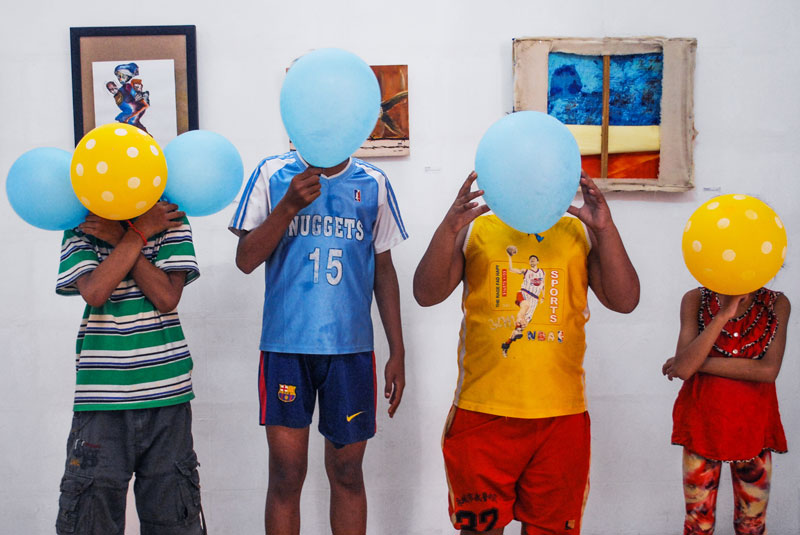
Maintained with extremely limited resources, the center—which hosts exhibitions, organizes workshops, provides arts training and serves as a meeting ground for creative minds—has weathered several storms over the years, rescued at one point after the artists donated works for a fundraising event.
Over the next few months, its existence will become even more precarious since the NGO Cambodian Children’s Trust, which oversaw the center for a year, has now pulled out due to budget constraints.
Sammaki is all the more important because Battambang has only two other venues to exhibit contemporary art, despite the surprisingly large number of artists who call the city home.
Because of the organization Phare Ponleu Selpak, which has trained young people from Battambang City in the arts since the mid-1990s, the city has a wealth of talented visual artists who are eager to exhibit in their hometown.
However, most buyers of Cambodian contemporary art continue to be foreigners, and anything hampering visitors’ access to Battambang—such as road construction in recent years—may affect the art market.

Still, the artists keep on working, said artist Srey Bandol, one of Phare’s founders, who has trained almost every artist in Battambang.
“Artists are not rich people anywhere in the world,” he said. “Those in Battambang are quite poor. But they’re strong…. They don’t have huge ambition: They just need a little money to buy food, color and the stuff to work with.”
This makes it crucial to keep a center such as Sammaki open, said Mr. Bandol, who sits on the board of Sammaki, which hopes to transform what has been an informal collective into a more systematic organization for the arts.
“We’re going to be a place where professional Cambodian artists can learn, can have exhibitions that further their CVs, and a place where [other] people…can come, have fun and be creative,” said Ben Valentine, the center’s resident artist and curator, whose photography exhibition “Battambang: Recent Works” is currently on display.
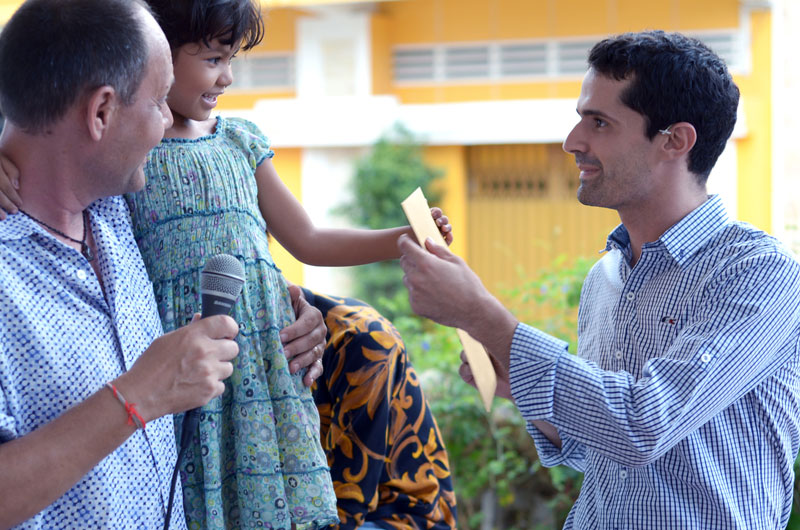
“Battambang” features black-and-white photos that Mr. Valentine took to reflect some of Sammaki’s daily activities: neighborhood children dropping by to draw, ask questions of artists or look at works exhibited.
“We’re contemplating adding the words ‘community art’ to the gallery name, because it is important to us that the communities get involved with the arts,” said Darren Swallow, a Sammaki board member who, with his artist wife Kchao Touch, runs one of the two other contemporary art venues in the city, the Lotus Gallery Bar.
“Artist Chov Theanly is a prime example of this community involvement,” Mr. Swallow said. “Theanly selflessly will stop his work—he’s using Sammaki as a studio at the moment—if there are young people who are interested, take the art books down…and give an hour lesson on history of art.”
The third art venue in the city came about through an effort to help artists who, although virtually destitute, were refusing to give up. Set up by Alain Troulet, a former director of the Institut Francais in Phnom Penh, Romcheik 5 New Art Space provides four artists with studio and living space. Currently, its residents are Bor Hak, Hour Seyha, Nget Chanpenh and Mil Chankrim.
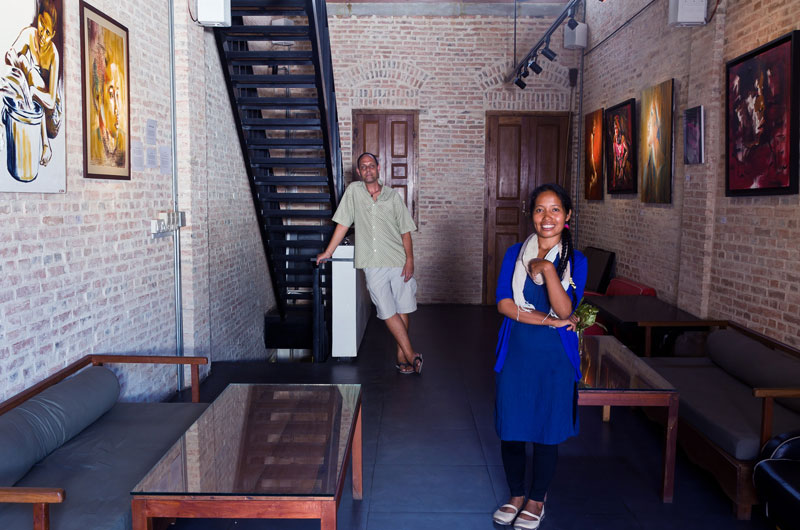
The modest facility recently expanded to add an art gallery with a wide program of exhibitions, plus a space on the upper floor where the four artists exhibit their work. “This was on my mind from the beginning: To have them keep a record reflecting the evolution of their work,” Mr. Troulet said.
Making artists aware of the need to document their journey is one example of the support they need, Mr. Swallow said. Helping them set prices is another, as some artists grossly underprice their works, while others overprice them.
“Every artist is trying to find who they are and move forward,” said Ms. Touch. “With Sammaki under our control, we need to continue to make it a place where artists share, learn and exhibit.”
—
Srey Bandol
“An artist is a person who creates new ideas, and those new ideas affect society and its way of living, of thinking,” said Srey Bandol.
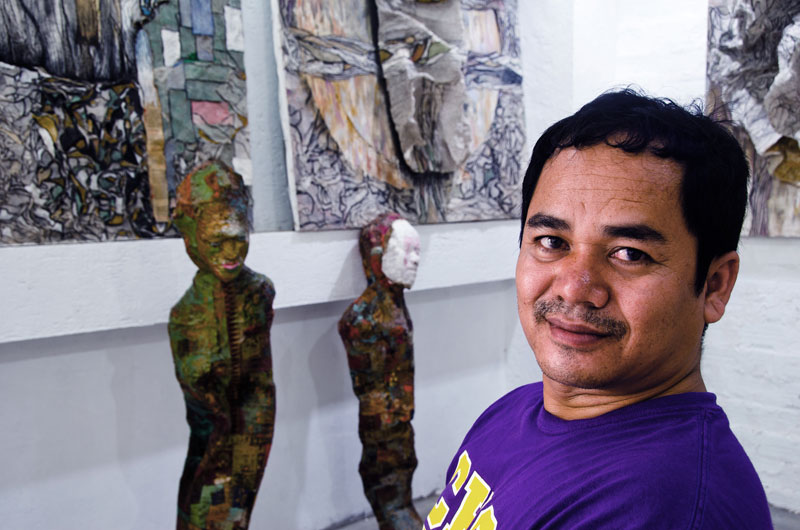
This is why conceiving of works for an exhibition takes time for Mr. Bandol, and why he intends to spend the rest of the year developing works for his next Phnom Penh exhibition, scheduled for 2016.
“It’s not just aesthetics. It’s the concept,” said the 41-year-old artist, who has been a mentor to many of Battambang’s young artists as well as having his own work exhibited in several countries. “I really want to create quality artwork and come up with a good concept.”
A founder of Phare Ponleu Selpak who has taught there since the mid-1990s, Mr. Bandol has not seen in his new students this year the same passion for art that he found in those of years past. The school now has a graphic design and computer animation program, and students are much more excited by these career prospects than by visual arts, he said.
“This may be general, not only the school story or problem but in the whole Cambodian society, as people now are only thinking computer technology,” he said.
One can hardly blame them, as the life of an artist is not easy, Mr. Bandol said. But fewer artists may come out of Phare from now on, creating a generation gap among Cambodian artists, he added.
Nov Cheanick
“People are used to seeing our final products at exhibitions, displayed in very clean and nice galleries,” the 26-year-old artist said. “So they don’t know the real life of painters.”
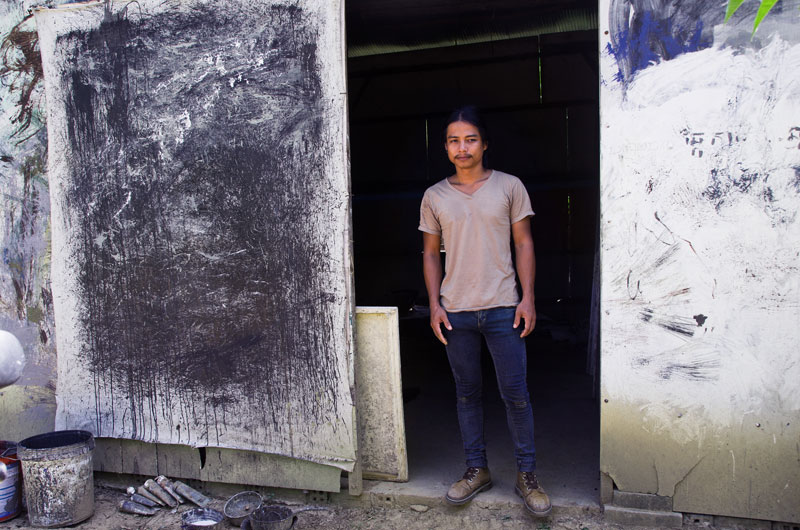
“We are not rich, but we are not poor at heart. We just want to have people start thinking when they look at contemporary paintings” as each work carries a message about today’s world, Mr. Cheanick said.
And they also reflect Cambodia’s identity, he added.
“Most people purchase something for an expected return, for example, to buy clothes they can wear and which make them look nice. But they forget that contemporary art is playing an important role in education, social change and development,” he said.
“It’s important that we use the arts to motivate them…to become aware of sorrow, environmental issues, political and social issues. So it’s our role to make people change their mindset.”
Like nearly every artist in Battambang City, Mr. Cheanick studied at Phare Ponleu Selpak. “Phare is a place where we’ve learned about art, while Sammaki is a place where we share knowledge, experiences, ideas regarding art,” and enable local children to explore the arts, he said. “Both places are crucial to artists.”
Pen Robit
When Mr. Robit was studying at Phare Ponleu Selpak in the mid-2000s, just a handful of students in his class opted to take visual arts, while the majority chose graphic design or computer animation.

“I admit…there’s much more employment in those fields,” the 24-year-old said. “A career as a painter means sacrificing everything for the love of art with no financial prospects. Because this career as a painter is like a venture,” and a risky one, he said.
“But in Battambang City, there is a strong connection among artists: We support and motivate each other,” Mr. Robit said. This support system includes Sammaki, which is why artists have been happy to contribute works to raise funds for it, he said. “If it was to close, it would be a big loss for us.”
Cambodian contemporary artists, he said, “are part of the country’s soul. So I think it would be such an amazing project if the Cambodian government built a modern art museum.” There would be no better way to disseminate information on Cambodian arts today, he added.
Mr. Robit said that no Cambodian had ever acquired one of his works. Instead, foreigners living in the country do.
“In addition, there’s an increasing market for our works outside the country as more and more painters are getting well-known abroad.”
Bor Hak
In Bor Hak’s opinion, a country can only develop if a contemporary arts scene is in place to reflect its progress through art.
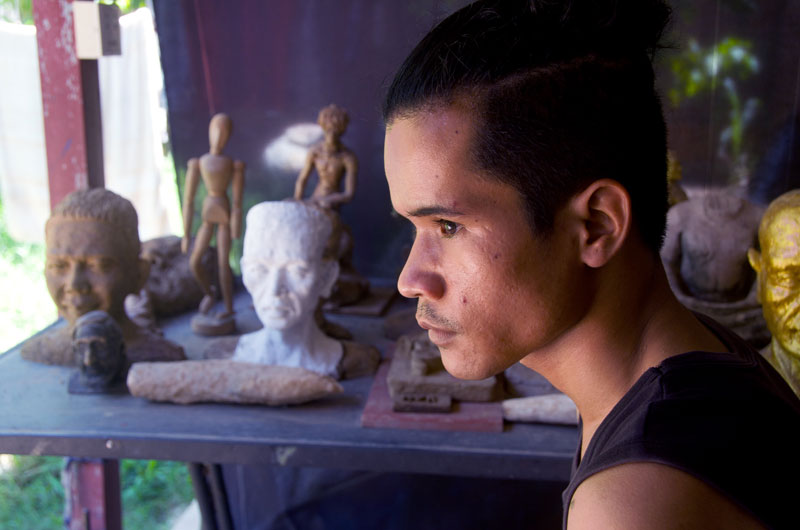
This is why the 24-year-old artist dreams of seeing contemporary art in Cambodians’ homes and government buildings as well as in hotels and guesthouses, and broadcast on Khmer-language television.
“When people see contemporary artworks, they start using their brains to figure out what the artwork means, what message is hidden there,” he said. “And when people think, they develop their ability to find answers to a great many issues.”
Introducing contemporary art to Cambodians should not be difficult, he said. “Cambodians already have art in their minds and blood.”
Mr. Hak is one of the artists who lives in the Romcheik 5 New Art Space, which gives him a studio to work in and a small room to live in and keep his guitars—music being his other passion.
“As artists, we absolutely need a calm and quiet place where we can concentrate to find concepts and ideas,” he said. “Especially when drawing, we need to be very calm and stay focused.”
Mr. Hak is currently working on a series of sculptures on the theme of freedom of expression.
Mil Chankrim
The 24-year-old artist has his studio at Romcheik 5, where he also lives.
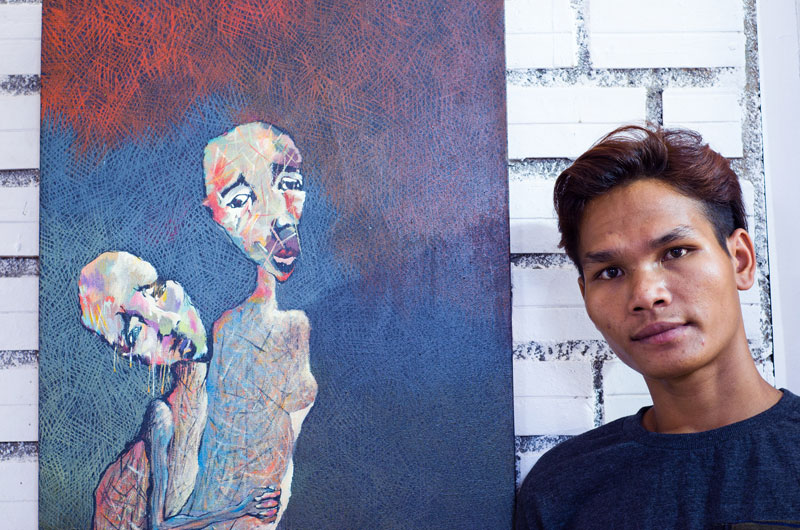
“We are just a small community,” he said of the artists in Battambang City. “We know each other pretty well. Of course, we are not rich in terms of money, but we are rich in ideas and opinions to put into our contemporary works.”
So far, only foreigners have purchased his work. “They understand our efforts and the sacrifices we make to paint.”
But Cambodian children and teenagers have started to drop by at exhibitions and ask questions about the works, he said. “I’m so glad because this means they are using their brains when looking at our work and trying to figure them out.”
Some Cambodians view contemporary art as being foreign: Because of the decades of war and conflicts, they don’t realize that there was contemporary art in Cambodia in the 1960s and early 1970s, he said.
“We have had contemporary paintings for several generations, but records and artworks were completely destroyed during the war,” he said.
But having young people ask questions bodes well, he added. “It’s a beginning.”
Morrison Polkinghorne
Morrison Polkinghorne is one of the foreign artists who, fascinated by the vitality of the Cambodian arts community in Battambang City, decided to move there.
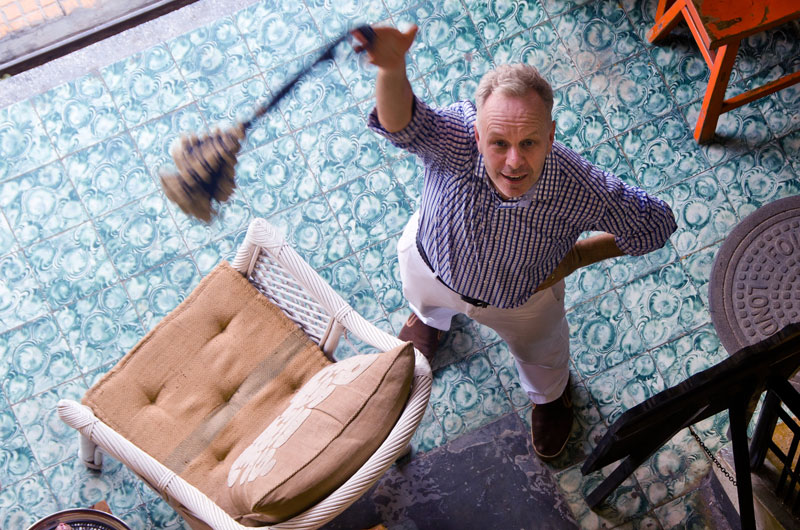
“I have a passion for contemporary art, and the contemporary art in Cambodia is mind-blowing,” the 48-year-old Australian said. So after a three-day visit to Battambang City last year, he went home to Sydney, packed his bags and relocated.
Mr. Polkinghorne creates trimmings such as tassels and braids for Australian designers who work on exclusive homes, luxury hotels and government buildings such as Kirribilli House, the Australian Prime Minister’s official residence, he explained.
These trimmings are made to order with natural fibers or jute threads. “I also like using…130-year-old Irish linen threads,” the textiles expert said.
Moving to Battambang City was also a business decision, he noted. “I can’t continue in Australia: I train people to do this work and they last two weeks, six months, are bored and leave.” But in Battambang City, he said, “I have four people who are phenomenal, better than anyone I’ve had in Australia…. I now have people who can make things, who want to work, and I love it.”
Mr. Polkinghorne has also found wood-turning and metal artists to produce pieces that go into the trimmings. “Having these people here, I’m able to create,” he said.



